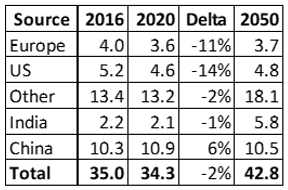Since the ratification of the Paris Climate Accord the US and Europe have significantly reduced emissions, yet little progress has been made worldwide due to rising carbon emissions (see Table 1). [1] According to the US Department of Energy Information Agency (EIA), [2] total world carbon emissions by 2050 would go up, even if the US and EU achieve net zero by 2050. [3] However, the US reversed direction in 2021, increasing coal production and carbon emissions by 9%.[4]


To reverse this direction, this article outlines the individual, corporate, and government strategies required to put the world on a path to net zero. Table 2 reveals the outcomes that must be produced to achieve net zero. Ultimately, citizens and consumers will need to demand governments and corporations implement these changes.
- Strategy 1: Strengthen performance-based energy efficiency standards (all sectors).
- Strategy 2: Restructure or liberalize world energy markets to accelerate innovation and investment into competitive renewable and carbon-free power production.
- Strategy 3: Power market restructuring will also expand markets for competitive high efficiency natural gas power plants to replace coal power, reducing carbon emissions by 65%.[5] Thereby, leveraging natural gas as a bridge strategy until non-hydro renewable power (today only 8%) scales.[6]
- Strategy 4: Accelerate sales and adoption of plug-in full electric (PEV) and plug-in hybrid (PEHV) vehicles.
- Strategy 5: Fuel switching – Replace 1) Coal fueled industrial processes (e.g., boilers, furnaces) with high-efficiency natural gas and 2) residential & commercial fossil-fueled devices with electric power.
- Strategy 6: Carbon capture through reforestation and sequestration.

To put the net zero challenge in perspective:

- Worldwide renewable power grew by 170 GW in 2018 compared to a required target of 315 GW/yr. over the next 30 years (9,400 GW total), see Table 2.[9]
- Total auto plug-in electric and plug-in hybrid electric (PEV and PEHV) sales of only 3 million/yr. worldwide compared to a required average target of 50 million/yr. for next 30 years.[10] Currently, 90 million vehicles sold per year.7
- One difficulty to overcome is the projected increase in coal-related carbon emissions from industrial and power use (see Figure 2). China and India produce 65% of worldwide CO2 and are projected to increase coal usage over the next30 years.2
We can expect national and state standards will be reinforced by consumers, local governments, and business actions. As important, setting a standard or requirement in a monopoly market typically results in inefficient deployment of capital and higher costs. The worldwide shift to open competitive markets such as freight, airlines, natural gas, telephone, and electric industries accelerated investment, innovation, and cost/carbon reduction.
The following actions by sustainable stakeholders will rapidly reduce carbon emissions and put the world on a path to Net Zero:
- Consumers/Residential: 1) install solar PV on homes, 2) purchase PEV/PEH vehicles, 3) purchase renewable power, and 4) buy from companies with net zero carbon footprints based upon SBTi,
- Buildings: Net Zero designs with LEED, building power meter aggregation, renewable power procurement, on-site renewable energy generation, grid harmonization, and distributed energy (storage, demand response).
- New Development: Implement Net Zero energy designs with meter aggregation, microgrids (e.g., solar, storage), and district energy. See city of Boston microgrid and district energy program as an example.[11]
- Industry: 1) Commit to and Initiate Environmental Sustainability Goal (ESG) requirements in the vendor supply chain, 2) shift auto and commercial fleet vehicle lines to PEV and PEHV vehicles as several major auto manufacturers have already committed to a full line of plug-in electric vehicles,[12],[13] 3) shift coal fired power and industrial boiler systems to renewable and high efficiency natural gas, and 4) embrace and invest in facility, campus, and city scale microgrids with local renewables (e.g. solar PV), storage, and completive procurement of grid supplied renewable power.
- Federal: 1) Set car and truck efficiency standards that can only be met with EV and PHEV, 2) Set a power production carbon standard minimum of 1,000 lbs./MWh4, 3) Implement carbon trading and renewable energy credit markets, and 4) Develop and promote carbon capture strategies and technology.
- States: 1) Implement renewable portfolio standards, 2) liberalize electricity markets due to the resulting exponential investment in wind and solar power (e.g. US renewable increased from 2GW in 1998 to ~100GW In 2019),[14] 3) enable retail electricity competition, 4) implement community choice aggregation (CCA),[15] 4) enable microgrids with local renewables, 5) implement performance-based building efficiency standards with the US Green Building Council’s Leadership in Energy and Environmental Design (LEED), 6) incentivize implementation of distributed energy resources (e.g., solar PV, storage) in buildings with LEED grid harmonization strategies, and 7) implement fuel switching incentives and standards, and 8) promote and incentivize carbon sequestration and capture.
- Cities: Develop and implement 1) Net Zero plans including 2) community choice aggregation (CCA),15 3) strategies for microgrids with community solar, 4) building meter aggregation requirements, 5) electric vehicle programs, 6) higher density town centers connected by green ped-ways, and 7) sustainable transit.
- Utilities: Develop and implement 1) Net Zero distribution programs including investment in two-way power flow distribution systems that can accommodate >90% adoption of plug-in vehicles and solar PV. 2) This also includes joint city/utility Net Zero microgrid plans and utility incentives for or ownership of substation generation, charging stations, and solar PV.
[1] https://www.wearestillin.com/signatories , https://unfccc.int/news/commitments-to-net-zero-double-in-less-than-a-year & https://unfccc.int/climate-action/race-to-zero-campaign
[2] https://www.eia.gov/outlooks/ieo/
[3] https://www.eia.gov/outlooks/ieo/
[4] The Kiplinger Report dated January 7, 2022
[5] https://www.nwcouncil.org/sites/default/files/Final_CCCT-Presentation_101613.pdf
[6] https://www.c2es.org/content/renewable-energy/
[7] The U.S. IEO 2050 projected carbon emissions include a 210% increase in renewable generation which displaces roughly 9 billion tonnes
[8] This strategy is included due to the significant impact on local air quality.
[9] https://www.irena.org/newsroom/pressreleases/2019/Apr/Renewable-Energy-Now-Accounts-for-a-Third-of-Global-Power-Capacity
[10] http://www.ev-volumes.com/country/total-world-plug-in-vehicle-volumes/
[11] http://www.bostonplans.org/planning/planning-initiatives/boston-smart-utilities-project/
[12] https://group.volvocars.com/company/innovation/electrification
[13] https://www.reuters.com/article/us-autoshow-detroit-ford-motor/ford-plans-11-billion-investment-40-electrified-vehicles-by-2022-idUSKBN1F30YZ
[14] DOE EIA Annual Energy Outlook 2002 and 2019, https://catalog.data.gov/dataset/annual-energy-outlook
[15] https://www.leanenergyus.org/about
Learn more:
Click here to learn more about Wunderlich-Malec’s sustainability solutions.
